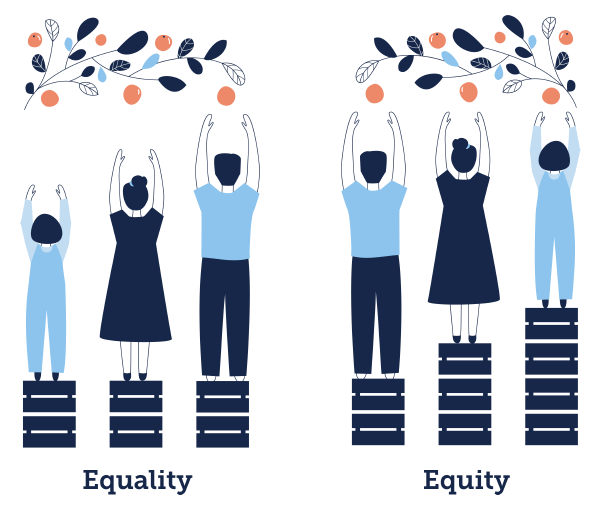It feels like the world is finally waking up to the fact that different perspectives create a colourful tapestry that helps drive positive performance and achieves amazing things. Understanding this is key to an effective workplace and creating a culture of belonging. So, when communicating about share plans or rewards, how can you make sure you include all of your colleagues rather than exclude? We’ll talk you through it.
A recap on inclusivity
The Chartered Institute of Personnel and Development (CIPD) define an inclusive workplace as “a place where people’s differences are valued and used to enable everyone to thrive at work. An inclusive working environment is one in which everyone feels that they belong without having to conform, that their contribution matters and they can perform to their full potential, no matter their background, identity or circumstances.”
Now a reminder of Equality vs Equity

To achieve inclusivity, we have to achieve equality, right? Wrong. Equality is making sure that we give everyone the same opportunity, and that’s difficult to achieve because every individual is inherently different. We need to think about equity. We need to level the playing field so that fairness happens along the path to success.
For example, when communicating, everyone absorbs information differently. Some may benefit from verbal communication, whilst others may benefit from visuals. If you’re communicating to your entire internal audience using one approach, you’re including everyone equally but not necessarily connecting with them and being equitable. Think about incorporating a range of communication styles when promoting your share plans or rewards internally. Being equitable in this way allows everyone to engage with your message depending on their preferred (sometimes necessary) method of communication.
Collaborate with internal teams to discuss how you can be more equitable when communicating with your colleagues.
Who are you communicating with?
As with any communication, the best way to get it right is to think about your audience first. Who are they, where are they, what do you want them to think, feel and do as a result of your communication, and what potential barriers could stop this from happening? This will help you decide the best message, method and tone.
For example, if you’re organising drop-in sessions where colleagues can learn more about share plans or rewards, offer a digital opportunity to include remote workers, like a Microsoft Teams meeting – a face-to-face meeting will only benefit those who are in the office and displays a sign of proximity bias.
Recognise your unconscious biases
We’re not going to unpack unconscious bias in great detail, but it’s essential to mention it here.
Unconscious bias is a term that describes the associations we hold outside our conscious awareness and control – this affects everyone.
According to Imperial College London’s definition: “unconscious bias is triggered by our brain automatically making quick judgments and assessments. They are influenced by our background, personal experiences, societal stereotypes and cultural context. It’s not just about gender, ethnicity or other visible diversity characteristics – height, body weight, names, and many other things can also trigger unconscious bias.”
Unconscious bias can have a significant influence on our attitudes and behaviours, especially towards other people. It can influence key workplace decisions and contribute to inequality, such as selection and recruitment, reward plan design and communication.
You can overcome unconscious bias when communicating your share plans or rewards by building a relationship with your audience, asking a diverse sample of people for feedback on your draft communications before they are finalised and acting on it – start co-creating!
Inclusive language
Why does inclusive language matter?
The language you choose is vital for helping everyone in your organisation feel like your message is for them. Remember, whether we intend to or not, the words we choose to use may include or exclude those around us.
Here’s a checklist for you to consider when creating your messaging:
- Not all people identify with being a man or a woman. Some may prefer gender-neutral pronouns and titles such as “they/them/their”.
- Moving away from binary language is more inclusive of people of all genders. Use “everyone” or “all” instead of “ladies and gentlemen” or “guys”.
- Consider using gender-neutral phrases such as “Chairperson” instead of “Chairman”.
- Focus on the accessibility barrier instead of the person’s impairment.
- Consider the difference between identity-first language, which puts a person’s condition or disability before the person (eg. ‘autistic person’) compared to person-first language (eg. ‘people with autism’) – it’s essential to respect the language people use to describe themselves.
The key thing to keep in mind is that we’re all learning how to be more inclusive – it’s a journey that requires conscious effort to overcome our habits and unconscious bias. If you make a mistake, use it as a learning opportunity and own the slip-up. It’s also worth noting that listening is one of the best ways to be inclusive, especially when you use the outcome to communicate in a way that appeals and connects.
Want to learn more?
If you need help communicating in an inclusive way, please get in touch as it’s our duty as communicators to help the workplace move to greater inclusivity.



